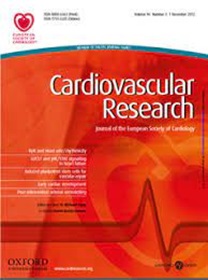通过反义寡核苷酸治疗肝脏靶向沉默 Angptl4 可减轻 APOE*3-Leiden.CETP 小鼠的高脂血症和动脉粥样硬化的发展
IF 10.2
1区 医学
Q1 CARDIAC & CARDIOVASCULAR SYSTEMS
引用次数: 0
摘要
背景和目的 血管生成素样 3(ANGPTL3)和 4(ANGPTL4)可抑制脂蛋白脂肪酶,从而调节组织从富含甘油三酯的脂蛋白(如 VLDL)中摄取脂肪酸。药物抑制 ANGPTL3 正在被评估为降脂策略,而全身性抑制 ANGPTL4 则由于不良反应而未被采用。本研究旨在比较沉默肝脏特异性Angptl3和Angptl4对减轻APOE*3-Leiden.CETP小鼠(一种成熟的脂蛋白代谢人源化模型)的高脂血症和动脉粥样硬化发展的治疗潜力。方法和结果 每周两次给小鼠皮下注射生理盐水或针对 Angptl3、Angptl4 或两者的肝脏靶向反义寡核苷酸,或混合寡核苷酸。测定血浆脂质水平、VLDL清除率和肝脏VLDL生成量,并评估动脉粥样硬化的发展情况。为了进行毒理学评估,用三种剂量的肝脏靶向 ANGPTL4 沉默寡核苷酸对绒毛猴进行治疗。肝脏靶向Angptl4沉默降低了血浆甘油三酯(-48%)和总胆固醇(-56%),这是因为棕色脂肪组织吸收了更多的VLDL衍生脂肪酸,而肝脏产生的VLDL较少。因此,Angptl4沉默可缩小动脉粥样硬化病变的大小(-86%)并改善病变的稳定性。肝脏Angptl3沉默同样减轻了高脂血症和动脉粥样硬化的发展。Angptl3和Angptl4的沉默分别降低了再进食和禁食状态下的血浆甘油三酯,而Angptl3/4的联合沉默则降低了血浆甘油三酯,与营养状态无关。在猴中,抗 Angptl4 ASO 治疗耐受性良好,无不良反应。结论 肝脏靶向Angptl4沉默能有效减轻APOE*3-Leiden.CETP小鼠的高脂血症和动脉粥样硬化的发展,肝脏靶向ANGPTL4沉默在非人灵长类动物中耐受性良好。这些数据证明了肝脏靶向 ANGPTL4 沉默疗法的进一步临床开发是有必要的。本文章由计算机程序翻译,如有差异,请以英文原文为准。
Liver-targeted Angptl4 silencing by antisense oligonucleotide treatment attenuates hyperlipidemia and atherosclerosis development in APOE*3-Leiden.CETP mice
Background and Aims Angiopoietin-like 3 (ANGPTL3) and 4 (ANGPTL4) inhibit lipoprotein lipase to regulate tissue fatty acid uptake from triglyceride-rich lipoproteins such as VLDL. While pharmacological inhibition of ANGPTL3 is being evaluated as lipid-lowering strategy, systemic ANGPTL4 inhibition is not pursued due to adverse effects. This study aimed to compare the therapeutic potential of liver-specific Angptl3 and Angptl4 silencing to attenuate hyperlipidemia and atherosclerosis development in APOE*3-Leiden.CETP mice, a well-established humanized model for lipoprotein metabolism. Methods and results Mice were subcutaneously injected twice-weekly with saline or liver-targeted antisense oligonucleotides against Angptl3, Angptl4, both, or a scrambled oligonucleotide. Plasma lipid levels, VLDL clearance and hepatic VLDL production were determined, and atherosclerosis development was assessed. For toxicological evaluation, cynomolgus monkeys were treated with three dosages of liver-targeted ANGPTL4-silencing oligonucleotides. Liver-targeted Angptl4 silencing reduced plasma triglycerides (-48%) and total cholesterol (-56%), explained by higher VLDL-derived fatty acid uptake by brown adipose tissue and lower VLDL production by the liver. Accordingly, Angptl4 silencing reduced atherosclerotic lesion size (-86%) and improved lesion stability. Hepatic Angptl3 silencing similarly attenuated hyperlipidemia and atherosclerosis development. While Angptl3 and Angptl4 silencing lowered plasma triglycerides in the refed and fasted state, respectively, combined Angptl3/4 silencing lowered plasma triglycerides independent of nutritional state. In cynomolgus monkeys, anti-ANGPTL4 ASO treatment was well tolerated without adverse effects. Conclusions Liver-targeted Angptl4 silencing potently attenuates hyperlipidemia and atherosclerosis development in APOE*3-Leiden.CETP mice, and liver-targeted ANGPTL4 silencing is well-tolerated in non-human primates. These data warrant further clinical development of liver-targeted ANGPTL4 silencing.
求助全文
通过发布文献求助,成功后即可免费获取论文全文。
去求助
来源期刊

Cardiovascular Research
医学-心血管系统
CiteScore
21.50
自引率
3.70%
发文量
547
审稿时长
1 months
期刊介绍:
Cardiovascular Research
Journal Overview:
International journal of the European Society of Cardiology
Focuses on basic and translational research in cardiology and cardiovascular biology
Aims to enhance insight into cardiovascular disease mechanisms and innovation prospects
Submission Criteria:
Welcomes papers covering molecular, sub-cellular, cellular, organ, and organism levels
Accepts clinical proof-of-concept and translational studies
Manuscripts expected to provide significant contribution to cardiovascular biology and diseases
 求助内容:
求助内容: 应助结果提醒方式:
应助结果提醒方式:


